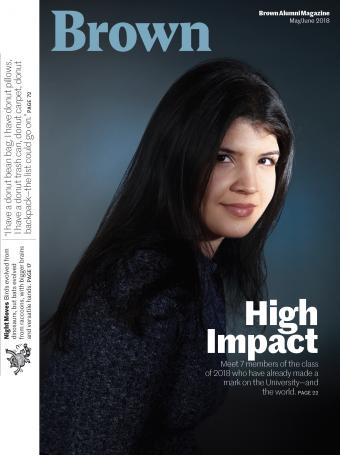PROVIDENCE, R.I. [Brown University] — Adam Moreno passed out feathers to first grade students at the Paul Cuffee School in Providence and watched their faces turn to complete awe. It was the first week of April, and the students were learning about birds.
Since he first started working as an animal care volunteer at 14, Moreno has been obsessed with everything about birds — their colors and feathers and flight and how he could see them anywhere he went. In the fall of 2016, Moreno took Feathery Things, a history class offered by Professor of History Nancy Jacobs. It focused on how birds interact with human cultures in different ways. For his final project, Moreno began work on a bilingual field guide, written in English and Spanish, showcasing 33 birds found in Providence and using images from a local photographer, Pam Tesler-Howitt.
“A lot of people living in cities have the impression that there is no wildlife here because it’s a city,” says Moreno, who has concentrated in ecology and evolutionary biology.

Moreno wants kids to appreciate the common birds they see around them every day and how these birds represent an important part of the landscape. Given that many people in Providence speak Spanish as their first language, Moreno felt it was important to gear his book toward Spanish speakers. In the field guide he writes of the epic migratory patterns of such birds as the ruby-throated hummingbird, which travels to Mexico and South America in winter.
“The idea is that migration is something that is wonderful and beautiful and should be admired,” Moreno says. “Borders are something we’ve set up arbitrarily, and moving and migrating is not something that should be looked down upon or make kids feel different or strange, but just a part of life. Birds don’t see country borders, they are going to go where they know home is.”
Moreno is working with the Cuffee School to launch a program that pairs Brown students with third and fifth graders for nature walks using donated copies of his field guide.
“My hope is that after the program, students will continue to use the book and explore and learn new things,” Moreno says. “Because it’s written in both languages, they can read it with their families at home and involve them in their outdoor learning experiences.”
Outside his avian education work, Moreno has conducted ecological research in Panama and Costa Rica and is the president of the Brown Poler Bears pole-dancing club. Moreno performed blindfolded in the Brown Aerial Arts Society’s spring show in late April to two nights of packed audiences in Alumnae Hall. The Poler Bears exists to promote the athleticism and artistry of pole dancing and to combat the stigma associated with it, Moreno says. “If anyone comes to one of our shows, that’s immediately erased,” Moreno told the BDH in 2017. This fall, he’ll enter Ohio State’s College of Veterinary Medicine, where he hopes to learn to treat birds and other forms of wildlife.
— Jack Brook, Class of 2019


